Menu
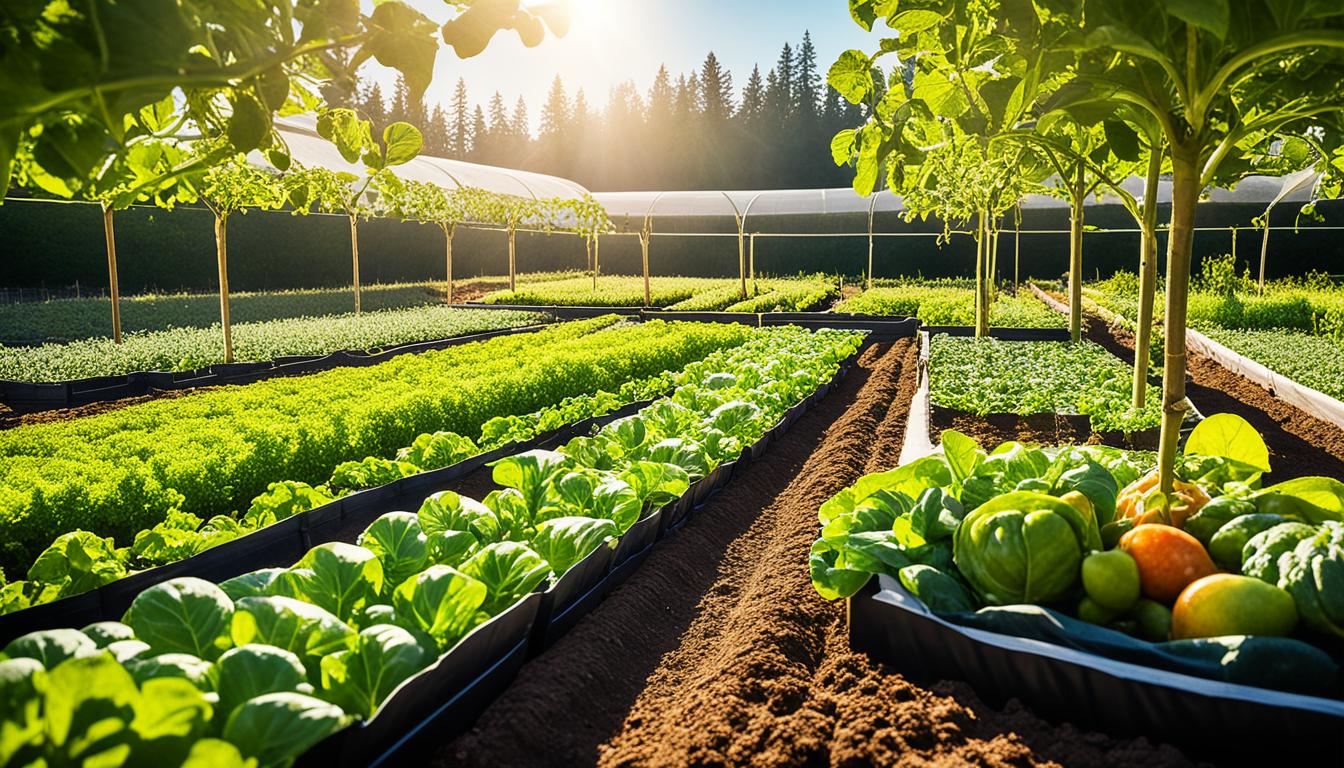
Did you know, as of 2019, organic farming covered 72.3 million hectares worldwide? This shows it’s getting more popular. But making the move to producing more organically takes a lot of skill. It’s all about using the land wisely, knowing what to plant where, and how to grow the best produce.
To get the best out of the land, we use things like organic fertilisers and soil changes. These help the soil be healthier and support the growth of tough plants. For over 30 years, we’ve been learning the best ways to do this.
Maintaining soil health is key in organic farming. It lays the ground for growing better crops. Things like the right pH, soil structure, and having lots of earthworms matter a lot. These lead to strong, green ways of farming, giving us more food in the end.
Soil pH is key to plants getting the nutrients they need. Adding lime or sulphur can help balance pH, based on soil checks. The Food and Agriculture Organization (FAO) says bad soil affects over 1.5 billion hectares. So, getting soil pH right is crucial to fight this problem.
Good soil structure helps water soak in better, roots grow, and boosts helpful soil life. By going the organic route, we can add 15-28% more soil carbon. This makes soil better. In India, more than 30% of farm soil is in bad shape. Using things like OrganiCal™ improves how soil holds together. It makes farming methods more eco-friendly.
Earthworms really help soils by turning nutrients over and making soil a better place for plants. India’s organic farms have more diverse soil life, which is super important. Boosting earthworm numbers using natural ways can increase crops by 25%. India has a huge amount of organic waste to make into compost. This is a big chance to boost earthworms and soil health naturally.
| Impact Factor | Organic Farming | Conventional Farming |
|---|---|---|
| Soil Organic Carbon (%) | 2.0 (+18%) | 1.7 (no significant change) |
| Microbial Diversity | 50% higher | Lower |
Organic farming thrives with a great nutrient management plan for high crop yield and rich harvests. Nitrogen plays a key role, managed through crop change and cover plants. Knowing how to manage nitrogen well is essential for great results in organic farms.
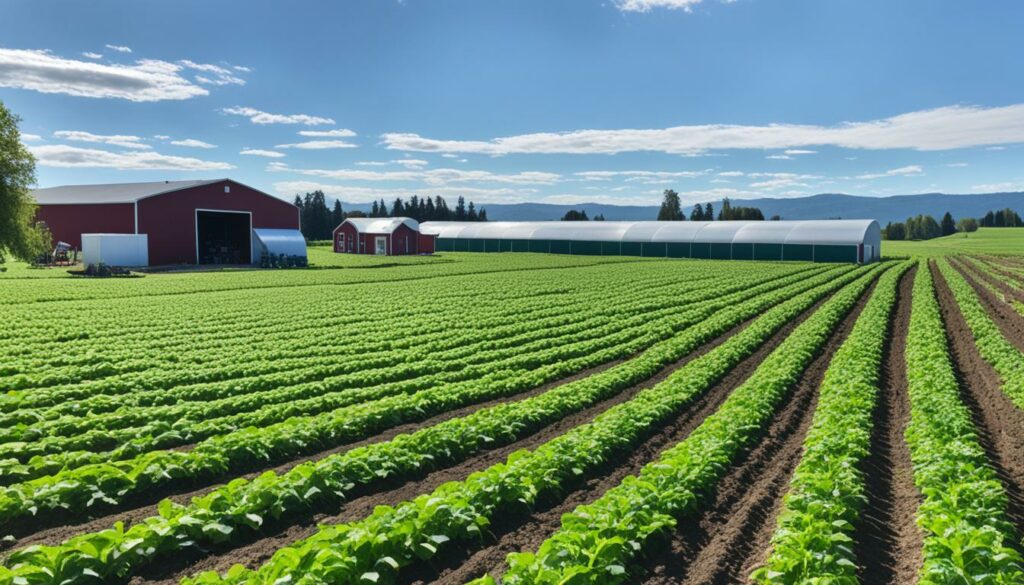
In sub-Saharan Africa, nitrogen usage was notably low at 1.1 kg per body in 2001. This was much lower than 22 kg in China and 38 kg in the USA. To solve this, we need to use planning tools that are free thanks to the USDA. These tools help use nitrogen better and rely on methods like swapping crops and eco farming to cut pollution and boost farming that’s smart for the climate.
Phosphorus is another vital nutrient often not used enough in some areas. In Southern Benin, plants needed 17 kg per hectare of phosphorus, but only got 0.5 kg. By using natural rock phosphate, we can make sure plants get the phosphorus they need to grow. The NRCS works to make plans better to support organic farming.
Using the right fertilisers is key to good nutrient management. The right ones help crops in many ways, from better growth to more crop. Making sure fertilisers are just right and from natural sources does wonders for the soil and increases harvests. This is seen in Southern Benin where the low use of some fertilisers shows the need for better options.
Taking on these strategies for managing nutrients and fertilising is vital in organic farming. It’s not just about good crops this year, but farming that lasts. By using these methods, we can reach our best with organic farming.
For sustainable farming, planting many different crops is key. This approach helps us grow more food and keeps the land healthy. It makes our farm better able to deal with challenges.
Planting different crops together can increase yields by 38%. This is good for the land because it makes the soil healthier. The soil can also hold more carbon. Adding in plants like beans can make the soil even better for growing.
In areas like the North China Plain, mixing crops led to more food and more money for farmers. It also cuts down on harmful gases quite a lot. These results show how good for the planet mixed crops can be.
| Benefit | Increase/Improvement |
|---|---|
| Equivalent Yield | 38% |
| Soil Organic Carbon Stocks | 8% |
| Soil Health | 45% |
| Cereal Production | 32% |
| Farmer Income | 20% |
| N2O Emissions Reduction | 39% |
| Greenhouse Gas Balance | 88% |
Cover crops are very important for growing food well and looking after the land. Plants like clover and vetch help block weeds and keep the soil safe. They also save water which is good for the earth. Using cover crops means we don’t need as many chemicals.
It’s key to use cover crops correctly to improve the soil and help seeds grow. When old plants break down, they feed the soil. This makes it a better place for new plants and good bugs.
Scientific studies show that using different plant types helps us grow more food. It’s a smart way to farm and look after the land for the future.
By mixing crops and using cover plants, we set up a strong, lasting farm. This kind of farming grows more food over time. Plus, it’s good for facing up to big challenges like climate change.
Getting the best yields in organic farms requires a detailed plan. This involves looking after the soil, handling nutrients well, and using natural agriculture methods. These steps help us produce more without hurting the environment.
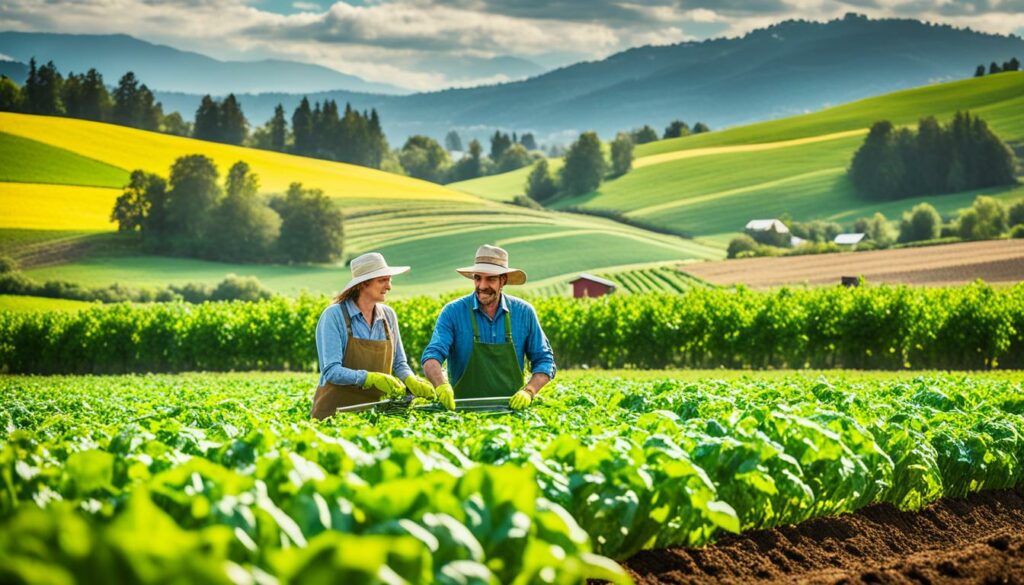
The amount of crops organic farms produce can be very different. This is mainly due to how farmers deal with diseases, weeds, and the soil. But, following the right steps can level this gap.
Looking closely, we see some key areas need work. This includes getting more from the land and making sure crops grow well. Better plant types and stronger plants help. Plus, tiny soil organisms are crucial for plants to get food and stay healthy.
There’s a team in Europe working on all this. It’s made up of experts and farmers. They study what stops us from getting more crops and share new ideas. Their goal is to help everyone grow better food.
Numbers show us how good organic farming can be. For example, there are more butterflies on organic farms than on usual ones. But, the best way to help butterflies is by setting aside land for them. Anyway, organic farming wins when it produces a bit more than half of the usual amount.
By mixing saving land with farmer-friendly ways, we can do well and save nature. This shows that making organic farming better helps everyone.
Organic farmers face the challenge of controlling pests and weeds without using chemicals. They understand that weeds can be a big problem. That’s why they focus a lot on how to deal with them. They use methods that are good for the environment and still keep their harvests high.
Biological pest control uses nature’s own checks and balances to keep pests in check. This includes using insects that eat harmful bugs, like ladybirds eating aphids. By using these methods, farmers can avoid using harmful chemicals. This helps the environment and makes farms more diverse and healthy.
In organic farming, tilling the soil is key to controlling weeds. This process stops weeds from growing by not letting their seeds sprout. But, it’s important to till at the right times to avoid damaging the soil. Researchers recommend tilling when weeds just start to grow, not when they’re already big.
Starting crops with the right fertilisers makes them grow fast and strong. This early growth helps crops beat weeds to sunlight and water. The fertilisers are safe for the environment and help the plants fight off weed attacks. They are a good, natural way to help crops grow well without chemicals.
We need to stop weeds from spreading quickly because they have special abilities, like growing fast and surviving tough conditions. By managing weeds well, organic farmers can keep their farms healthy and productive. They do this in ways that are good for the planet.
| Method | Benefits | Challenges |
|---|---|---|
| Biological Pest Control | Eco-friendly, promotes biodiversity | Initial setup, monitoring |
| Tillage | Disrupts weed seed germination | Potential soil erosion, timing critical |
| Starter Fertilisers | Speeds up crop canopy, suppresses weeds | Requires precise application |
By using a mix of natural pest control, tillage, and early fertilising, organic farmers can do well. These methods increase their harvests in a way that’s friendly to the earth. It’s about using natural ways to keep weeds away and help plants grow strong.
In organic farming, using the best seeds is very important. The right seeds can make a big difference in how well crops grow. They can boost the farm’s overall productivity too. While good seeds might be a bit more expensive, they pay off in better harvests. They also meet the high standards of organic farming.
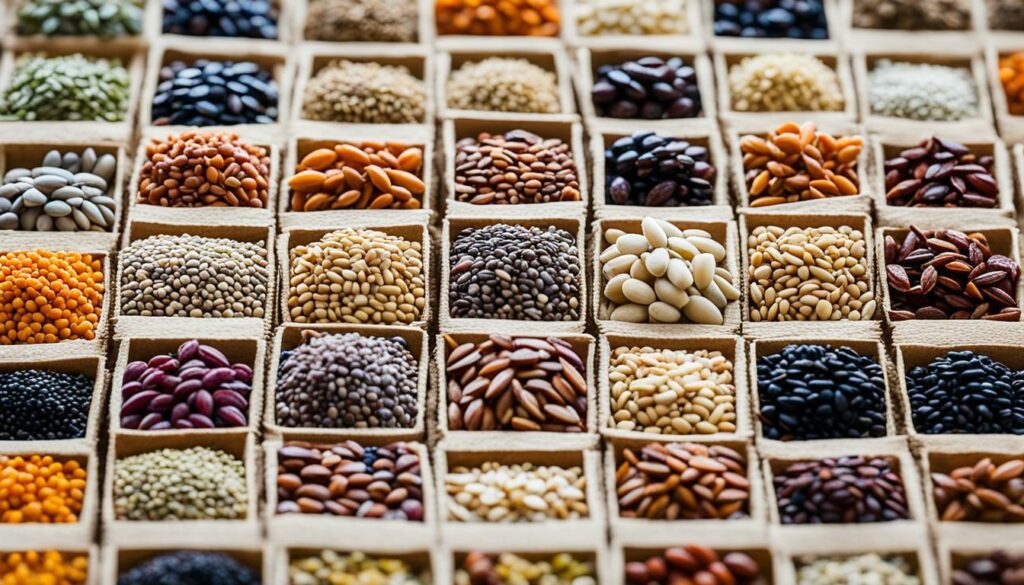
Certified seeds are vital for organic farming to succeed. They are guaranteed to be pure and strong. This means they grow into healthy plants very well. Using them ensures your crops are both high in quality and caring for the environment. They are carefully placed in fields, which helps them grow even better.
Enhancing seed performance is key for a better harvest. Coatings that are good for the seeds protect them. They defend against diseases and pests, keeping the plants strong. Thanks to new technology, we can treat seeds in better ways. This makes the soil healthier and the farming more nature-friendly.
In addition, new tools in farming help know the perfect time and place to plant seeds. Tools like EOSDA Crop Monitoring are great. They use high-quality satellite images and weather predictions to manage the fields well. All these new methods together not only increase crop amounts but also protect the earth for the future.
Using sustainable irrigation is key for getting the most out of farms, especially when water is scarce. By using modern systems, farmers can grow more while saving water.
In areas like the Huang-Huai-Hai Plain in China, water is drawn too much from the ground. This lowers the water levels. Here, using efficient systems like drip and micro-sprinkler irrigation is very important. Drip irrigation can use 29% less water. It also makes the use of water 92.2% better than older methods. Micro-sprinkler systems can increase crop yield by 5.3–18.9%. They can also save a lot of water, about 20–110 mm each year.
Knowing the weather well helps plan when to water fields. Take the Huang-Huai-Hai Plain, for instance. Most rain falls there between July and September. Winter wheat, grown later, needs a lot of water but doesn’t get much rain. Good weather predictions can make sure crops get the water they need. This both boosts harvests and saves water.
By combining these smart irrigation ways with good weather forecasts, farms work better. Using models like WHCNS helps manage how much water the soil and crops need. This means better and more consistent harvests. It also helps keep farms productive over time.
Composting is key in sustainable farming. It turns organic waste into useful soil additives. This boosts soil health by returning needed nutrients and increasing organic matter.
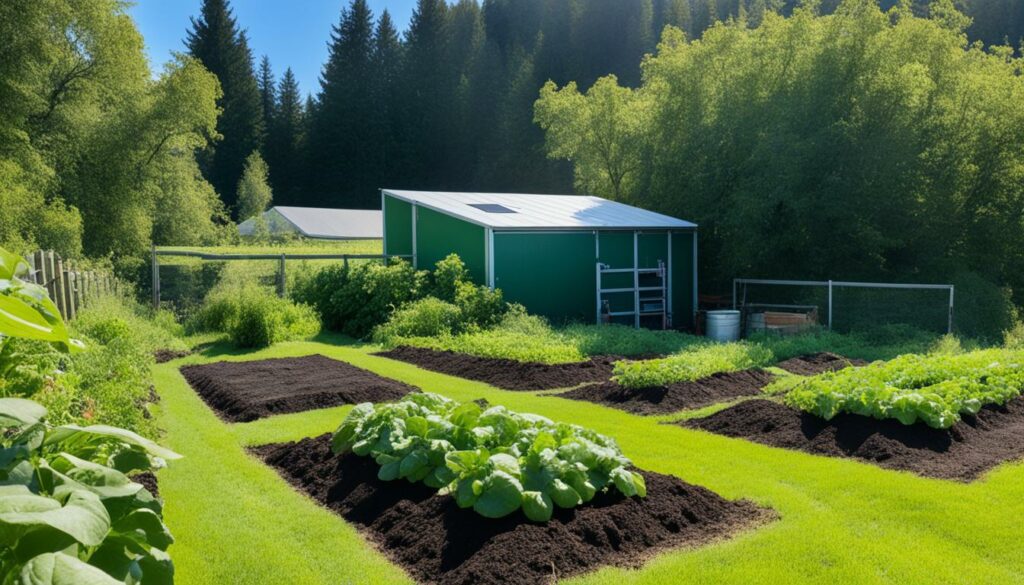
Using compost improves soil in known ways. It adds about 29% more organic matter in crop fields and 34% in grass areas. This boosts soil health and helps farming, especially in organic approaches.
Good use of organic waste is big in natural farming. How much compost used varies a lot. For example, it can range from 18 dry tons per acre in wheat fields to 165 Mg/ha in some crop studies. This shows why we need to adapt composting to each crop and soil to get the most benefit.
Making and using compost needs care. Places growing crops like corn and wheat could make about 2.2 to 1.2 tons of compost per acre, respectively. But actual needs might be much more. In some cases, you’d need nearly 4 million acres to produce enough compost for just one acre. New composting methods and using special soil boosters are key to make more compost in a sustainable way.
| Application Rate (dry tons/acre) | Compost Production Potential (tons/acre) |
|---|---|
| 18 (Dryland Wheat) | 2.2 (Corn) |
| 165 (Croplands) | 1.2 (Wheat) |
| 7 kg/m2 to 142,957 tons/acre (Rangelands) | Varies |
Organic additives are vital for sustainable farming. They improve soil, its nutrition, and health for a long time. Using these techniques can also up crop yields by 27% more than just using mineral fertilisers.
Precision farming techniques change the game in organic farming yield optimisation. They use high-tech methods and smart ideas to boost crop growth. This happens without harming the environment.
Field productivity zoning finds the most productive spots in fields. It looks at soil and past crops to know what each area needs. This smart method helps grow more crops with less effort.
Using tech in crop monitoring is a must now. Sensors and drones give us instant info on crops. This lets us water, feed, and protect them the right way. The use of tech is key for organic farming yield optimisation and saving resources.
Putting fertilisers exactly where they’re needed is crucial in precision farming. By using satellites and special software, we give crops just enough. This stops waste and helps crops grow better. It’s a big step in organic farming yield optimisation.
| Commodity | Practice | Benefit |
|---|---|---|
| Wheat | Field Productivity Zoning | Improve nutrient utilisation |
| Agronomic Peas | Monitoring with Technology | Optimise irrigation |
| Kamut | Smart Fertiliser Application | Enhanced growth rates |
Weather patterns greatly affect how much food we can grow. This makes it very important for farmers to change with the climate. They should use weather analytics to plan ahead. Extreme weather events, such as high heat, little rain, floods, and sudden cold snaps, can harm crops. They’re especially bad when plants are still young. This is why smart farming and planning are key to getting the most out of the land.
Climate change is a big threat to farming all over the world. Droughts can reduce the amount of food we grow, causing farmers to lose a lot of money. These changes are hitting important crops hard, such as wheat, maize, rice, and oilseed rape. If we don’t adjust, we could be looking at a 12-20% drop in food crops by the end of this century. High levels of CO2 have actually helped some crops grow more, but too much can harm the soil. Using methods like conservation tillage can help the soil hold water better.
But if we keep planting the same thing in the same place without tilling, the soil can get too hard. This is called soil compaction and it’s not good for crops.
High-precision weather forecasting tools are game-changers for farmers. Things like the Meteomatics model and EOSDA Crop Monitoring can give you weather info down to 90 metres. EOSDA also tells you what kind of weather to expect over the next 14 days.
This helps farmers with things like when to plant, when to water, and even which fields to use. It saves money and makes crops healthier.
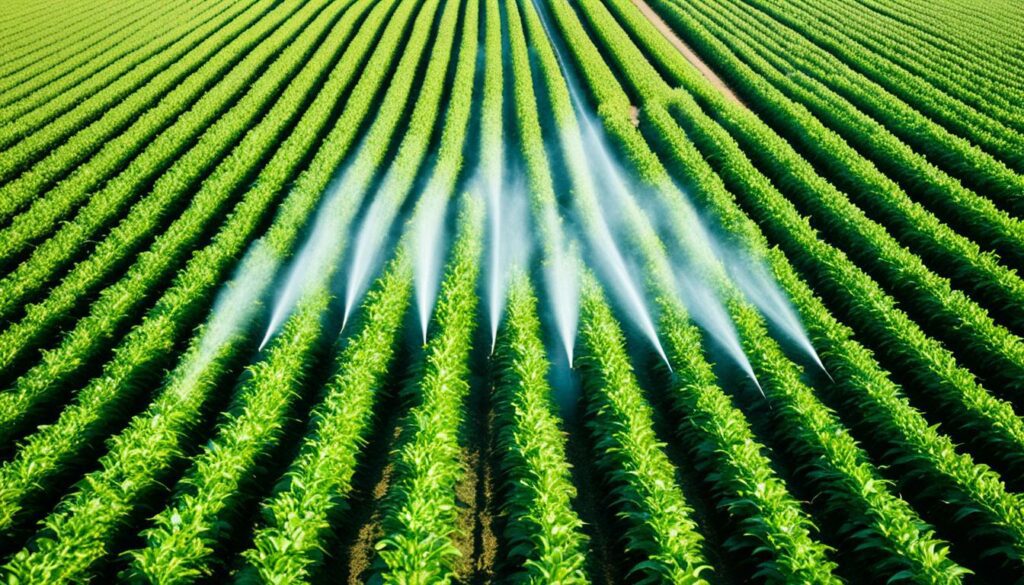
Weather data also helps businesses, advisers, banks, and insurance companies alike. It lets them give advice, assess risks, and do financial planning. Using advanced technology and detailed weather data, we can keep farming in a smart way. This way, we get the most food out of our fields, all while being kind to the environment.
Keeping organic certification up means understanding the standards and sticking to them. This is key for farms that want to increase their organic yield and enter top markets. By doing this, they commit to sustainable ways of farming.
Organic farmers must follow strict rules to be certified. There are over 72 million hectares of organic farmland worldwide, proving how big this market is getting. This shows the constant effort to keep the farming methods of high quality, helping the global market grow.
In each country, a specific group makes the rules for organic farming. These rules focus on how the food is grown, saying no to artificial pesticides or fertilizers. Instead, farmers use natural methods to protect the land and grow more food.
Staying certified means always following the important rules. The USDA has invested a lot in helping farmers continue organic practices. This support benefits many farmers and millions of people who choose organic food.
Starting March 19, 2024, a new rule will make sure all organic imports to the U.S. are truly organic. This step increases honesty in the organic food chain.
Groups like Oregon Tilth and the Organic Farming Research Foundation are also helping out. With extra money from the USDA, they are working to make the organic world better. These steps help keep the organic farming community strong and in line with international standards.
Overall, keeping a farm certified is an ongoing journey. It involves knowing the standards, using eco-friendly methods, and working with regulators. All this aids in increasing organic farming’s success through sustainable methods.
Organic farming tackles pest and weed problems without harmful chemicals. It uses natural farming techniques. This way, we keep our crops safe and follow earth-friendly practices.
To stop pests, it’s best to prevent them. Try things like changing which crops you grow and planting covers. This mix-up makes it hard for pests to stick around and helps your farm produce more. Plus, using good bugs and friendly germs as pest buddies keeps the bad bugs away without pesticides.
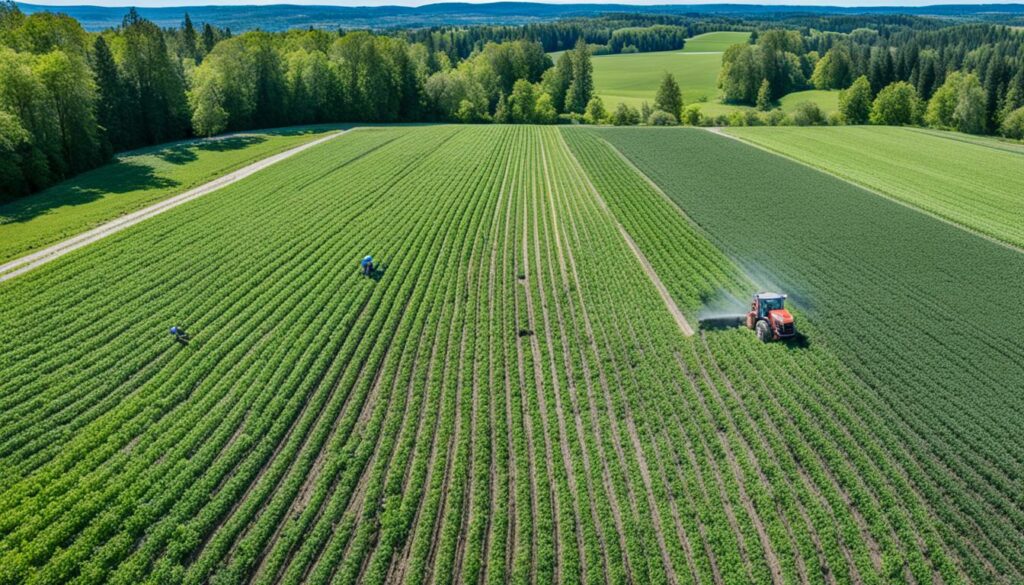
Keep your fields in check by looking over them often. Use tools like traps to catch pests early. By spotting and stopping them quickly, you can keep your crops healthy without using harmful sprays.
Small nutrients do big work for plants. Giving crops things like MicroHume® makes them stronger and more productive. This also helps plants fight off pests and diseases. So, organic food is not just good for us but also fights pests on its own.
Organic ways aren’t just about pests and weeds. They’re also about better soil and stronger plants. This mix helps nature and farm goals work together to have healthy farms and better harvests.
Organic farming mixes new ideas with old tricks to solve farm problems. It carefully plans to fight pests before they start and feeds plants smartly. This keeps farms going and makes food good for us and the planet.
| Weed Type | Challenges | Organic Solutions |
|---|---|---|
| Canada Thistle | Persistent perennial | Crop rotation, root disturbance |
| Johnsongrass | Grows up to 7 feet, difficult to manage | Frequent tilling, cover crops |
| Quackgrass | Spreads via rhizomes, complex control | Flame weeding, targeted tilling |
| Giant Ragweed | Rapid growth, high seed production | Early intervention, diverse rotations |
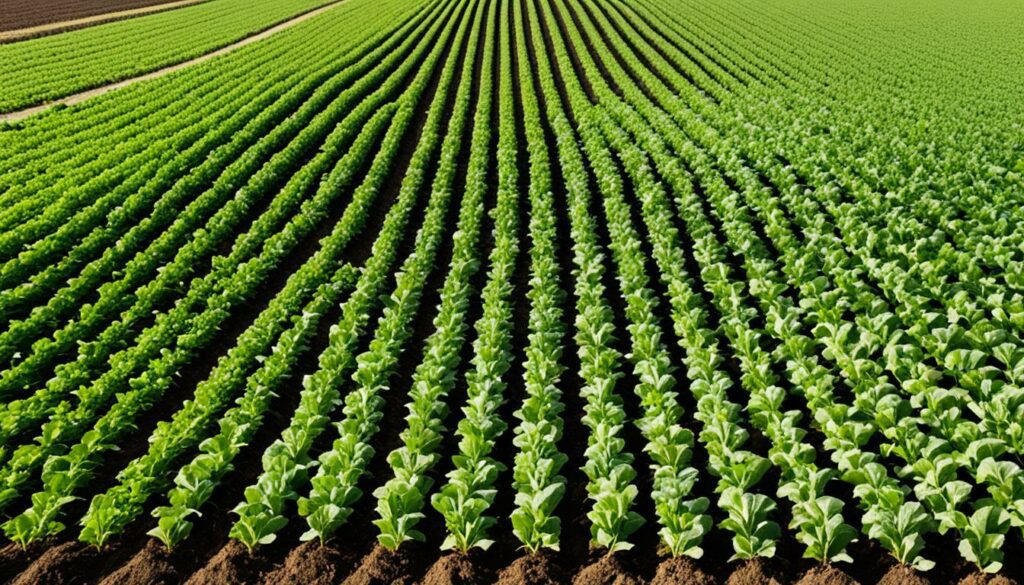
To improve crop yields and support organic farming, enhancing biological soil activity is key. It involves using eco-friendly farming approaches to boost the variety of microbes in soil. This can lead to better soil health and more productive farming.
Without a doubt, microbes are important for moving nutrients around and keeping soil strong. Adding organic stuff to soil makes crops grow better. For instance, wheat did notably well, up by 40.49%, compared to other plants.
But with the good comes the bad. Broccoli, for example, gathered a lot of antibiotic genes, which isn’t great news. This highlights the importance of picking the right stuff to put in the soil. It depends on what plants’ helpers (microbes) can eat, as some amendments work better for certain crops.
Let’s not forget earthworms. They’re soil heroes, keeping it loose and rich in nutrients. More earthworms can mean a better harvest. They are especially helpful in farms that don’t plough the soil. These farms cover a big part of the US, almost 96 million acres in 2012.
Nearly all of this kind of farming also uses cover crops. Cover crops are essential for the health of the soil in these no-till fields. Pairing them with compost boosts the soil’s organic carbon. This has been shown to improve the farm’s health in places like Washington, Iowa, and Florida.
| Crop | Yield Increase (%) |
|---|---|
| Wheat | 40.49 |
| Maize | 36 |
| Millet | 29 |
| Rice | 8 |
In short, making the soil rich in life with diverse microbes and earthworms leads to better farming results. These methods not only boost soil but also keep farming sustainable. This helps in having healthier crops to harvest.
We’ve seen that getting the best from organic farming needs a smart mix of methods. These include good soil health, the right use of nutrients, and smart farming. While switching to organic methods might mean lower yields at first, the long-term benefits shine through. Over time, organic farms often do better than traditional ones, proving the value of these methods.
Experience and using the best practices have a big impact on yields getting better with time. It seems that a farmer’s know-how matters more than the quality of the soil. But, we can’t forget how organic farming changes the soil’s biology and nutrient flow for the better. Adding in more crop types, dealing with pests smartly, and using precise farming methods also help close the yield gap.
To sum up, success in organic farming comes from blending the right methods with always learning and improving. By sticking to these strategies, organic farming can be a strong, efficient, and green way ahead for the planet. The fact that more land worldwide is being used for organic farming shows its growing importance. Let’s keep getting better at organic farming, making it strong, efficient, and ready for the future.
To boost organic farming yield, focus on using organic fertilisers and keep the soil healthy. Rotate crops and mix different plants. This method helps increase what you grow.
Good soil helps plants grow strong and resist problems. To keep soil healthy, balance its pH and add nutrients. More earthworms mean healthier soil too.
Change where you grow crops each year. Plant extra crops in between. Also, use natural fertilisers. These steps keep nitrogen levels right and help plants grow well.
Changing the crops helps the soil, fights pests, and makes the farm stronger. As a result, you can grow more and better crops every year.
For pest and weed control, try using helpful bugs and careful planting. Starting plants off right also reduces the need for chemicals.
Good, tested seeds meet organic rules and help you get the most from your land. They are proven to grow well.
Use good watering systems and information about the weather to water wisely. This saves water and helps your plants thrive.
Making compost turns trash into plant food. It makes the soil richer, helps plants grow, and increases your harvest.
Precision farming uses special maps and tools to plan smartly. By focusing on where plants need help, it saves resources and boosts their growth.
To deal with changing weather, use advanced weather tools and smart farming. These steps protect your farm and what you can grow.
Know organic rules and stay in touch with certifiers. Follow the standards to make sure your farm is truly organic.
To prevent pests, make plants strong with special nutrients and add good bugs. Treat seeds to stop diseases early.
Having more small, helpful creatures in the soil makes a big difference. They make soil healthier, helping your plants grow more.